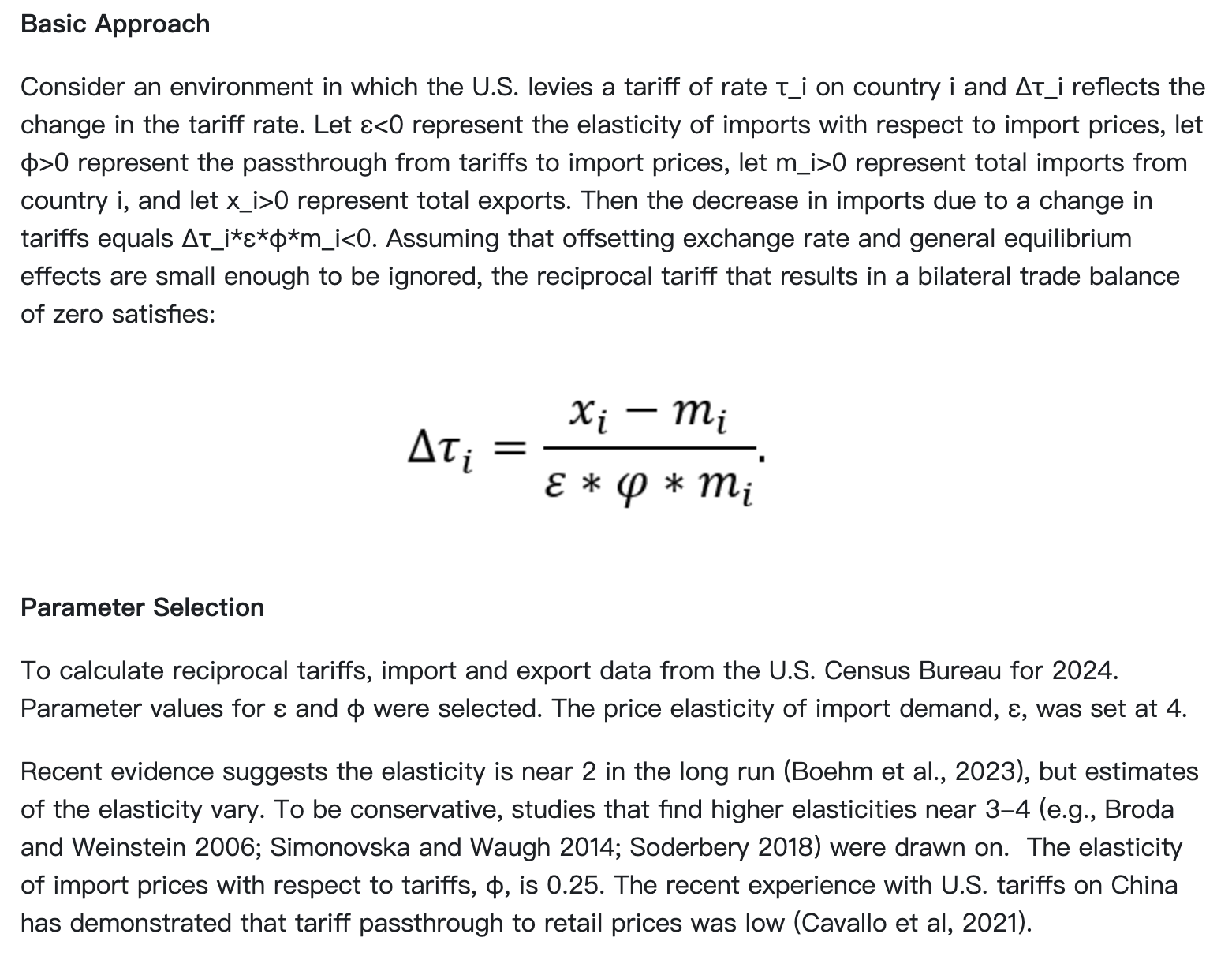US President Trump promoted the "Reciprocal Tariffs" policy, attempting to impose high tariffs on countries with trade deficits using a mathematical formula as a trade retaliation tool.
However, according to economists from the American Enterprise Institute (AEI), the core calculation formula of this policy contains a critical error, leading to a tax rate overestimation of up to 4 times, causing innocent countries to bear huge tax burdens, with the most typical cases including Switzerland and Taiwan.
Tariff Calculation Fails, Tax Rate Overestimated by Four Times
According to the Economic Times report, AEI economists Kevin Corinth and Stan Veuger pointed out that the Trump administration's method of calculating "Reciprocal Tariffs" is to divide the US trade deficit with a country by its total imports, thereby deriving a tax rate. The problem is that the Trump administration mistakenly used the "transmission rate of tariffs on retail prices (0.25)" as the "transmission rate of tariffs on import prices," leading to a significant overestimation of the entire formula. In fact, the correct transmission rate should be 0.945, meaning almost all tariffs would be reflected in import prices, rather than only affecting retail prices.
The two scholars criticized that the Trump team misused the transmission rates of different price levels, which is a logical error in basic economic theory. For example, if calculated using the correct formula, the tariff on Vietnam should be 12.2%, but the Trump administration's erroneous calculation proposed a punitive tariff as high as 46%.
Detailed Explanation of Reciprocal Tariff Calculation
According to the explanation of "Reciprocal Tariff Rate Calculation" published on the US Trade Representative's website, this formula is used to calculate how much punitive tariff (Δτ_i) the US should impose on a country to eliminate bilateral trade deficits (i.e., make exports = imports). The specific reciprocal tariff formula is:
The difference between US exports to and imports from a country (i.e., trade deficit), divided by a set of parameters representing import price sensitivity to tariffs.
Explanation of each parameter:
Δτ_i (Delta tau): The new tariff rate (%) the US adds to the i-th country.
x_i: The US export amount to that country.
m_i: The US import amount from that country.
ε (epsilon): Import demand elasticity to price, meaning: when import commodity prices change (e.g., becoming more expensive due to tariffs), how much will US import demand change.
➤ It is a negative value (because price increases, demand will drop), but the absolute value is usually taken in the formula.
φ (phi): Tariff transmission rate to import prices (passthrough), which means how much of the tariff will be transferred to the actual import price.
Where Did the Trump Administration Go Wrong?
According to AEI economists, the key error of the Trump administration was the misuse of the "tariff price transmission rate" (φ) parameter. The Trump administration used φ = 0.25 in the calculation, which is actually the "tariff transmission rate to retail prices," reflecting price changes after import through distribution and retail stages. However, the formula actually needs the "tariff transmission rate to import prices," which is how much the import commodity price will immediately respond once a tariff is imposed. Scholars point out that the correct value should be φ = 0.945, with a difference of nearly four times, leading to a 4-fold overestimation of reciprocal tariffs.

Switzerland Imposed 31% Tax Rate: "We Don't Impose U.S. Tariffs at All!"
One of the most obvious victims of the erroneous tariff formula is Switzerland. Despite imposing 0% tariffs on U.S. imports and creating 500,000 jobs in the United States, Switzerland was still subjected to up to 31% "equivalent tariffs" by the Trump administration. Swiss President Karin Keller-Sutter publicly stated that she "cannot understand" this, but emphasized that she will not retaliate for now and is inclined to negotiate with the U.S. side.
The New York Times reported that Switzerland's exports to the U.S. are mainly in chemicals, pharmaceuticals, and gold, resulting in a U.S. trade deficit of $38.5 billion with Switzerland in 2024. Since Trump's calculation method does not look at actual tariff policies but only the total trade deficit, even though Switzerland's trade behavior is essentially friendly, it was still heavily taxed.
Taiwan Imposed 32% Tax Rate Solely Due to Trade Deficit
A similar situation occurred with Taiwan. Taiwan's exports to the U.S. reached $116.3 billion in 2024, with a trade surplus of $73.9 billion. The Trump administration calculated a 64% "equivalent tax rate" based on this data, then halved it, resulting in the current 32% tariff on Taiwan. This completely disregards Taiwan's actual tariff policy towards the U.S., using only the trade deficit as the sole basis for taxation.
According to AEI economists, the actual tax rate might be around 8% if the incorrect elasticity adjustment is corrected, far lower than the current setting. This error not only damages Taiwanese manufacturers' export competitiveness but may also mislead understanding and support of trade policies within the U.S.
Academia Criticizes: No Economic Theoretical Basis
The Trump administration emphasizes the concept of "equivalence" to balance trade accounts, but due to formula errors, it distorts the market instead. Harvard Professor Alberto Cavallo, though one of the research sources cited by the U.S. side, also stated that he is uncertain whether the government has correctly used his research results. AEI scholars directly stated:
"This formula is neither economically sound nor has any basis in trade law."
If the policy is based on an incorrect formula, it will not only bring distorted economic consequences to the U.S. itself but will also have unexpected impacts on other trading nations. Swiss watchmakers and chocolate manufacturers have begun to raise prices for U.S. sales, reflecting cost pressures, while U.S. consumers may face price increases, and market concerns about potential inflation are gradually emerging.






